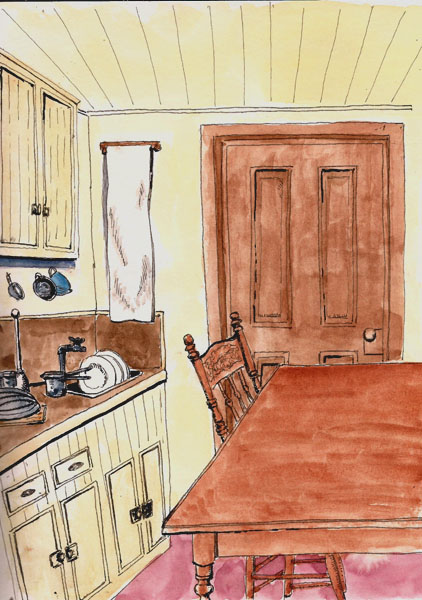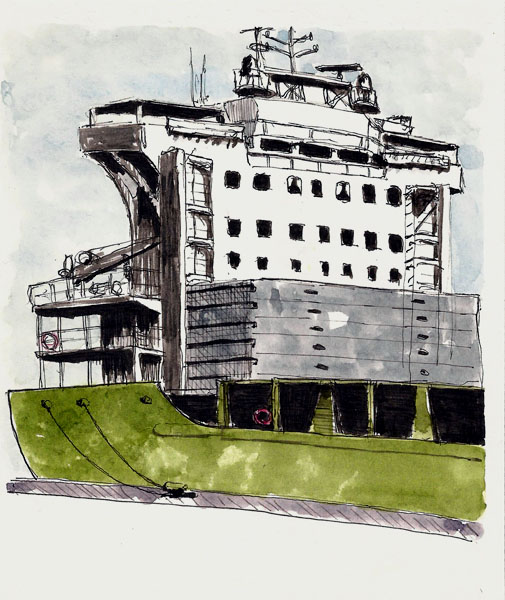I have caught more than a little criticism when I’ve said things in internet groups that are less than flattering about my own sketches. Mostly those comments come in the form of ‘don’t be hard on yourself’ and ‘there are no mistakes in art.’ I often wonder if these comments don’t say more about the people writing them than about me. It’s always seemed to me that the best opportunities for learning come from when I’ve made a mistake. If I don’t acknowledge my mistakes, I can’t learn from them. One thing is clear, I NEVER learn anything from my successes. They are but a reflection of what I already know. It’s the mistakes that expose what I don’t know or things I’ve yet to master.
 I study my mistakes often (I’m comfortable enough with myself that this doesn’t bother me) and I thought I’d share one such analysis. This sort of thing doesn’t see the light of day very often, though, in this case I did post the sketch as documentation of a sketching session I did with Yvan at Maison Alphonse-Dejardins.
I study my mistakes often (I’m comfortable enough with myself that this doesn’t bother me) and I thought I’d share one such analysis. This sort of thing doesn’t see the light of day very often, though, in this case I did post the sketch as documentation of a sketching session I did with Yvan at Maison Alphonse-Dejardins.
When doing a sketch like this I would normally draw, very lightly in pencil, a series of cubes to locate and proportion the two cabinets and the table. I didn’t do that in this instance. I just “went for it” as some would advocate. Not bad advice but when the drawing becomes more complex, it’s far better to start with a bit of scaffolding for two reasons. The first is that it lets you compare that scaffolding to what you’re looking at and allows you to correct it before continuing. Second, once the scaffolding is in place, you can stop worrying about proportions/locations and just have fun drawing.
My approach started with “Simple enough, I’ll just draw the high and low angles of the scene and proceed from there.” With those two lines in place and a horizon line, I felt everything else would fall into place. You can see that decision reflected in the red horizon line and the two blue angle lines that frame the scene.
This is where things went haywire. Notice the two green lines. I drew the left-most line first. I’d let my vanishing point wander left quite a bit. Then, wanting to nail down the table edge, I drew that line. Notice that my brain pulled it back towards the proper vanishing point somewhat but as I drew it I’m sure I was looking at the countertop line and “saw” the relationship between them and my brain struck a compromise, trying to accommodate the proper vanishing point as well as the relationship between table and countertop.
In my opinion, THIS is the sort of frustration that comes from not doing preliminary scaffolding. You’re constantly chasing your last error, trying to accommodate it into the drawing and one thing is certain, two wrongs don’t make a right in sketching.
Notice that when I drew the doors on the lower cabinet (orange line) my brain had returned to the vanishing point and while these look the worst when it comes to alignment to the rest, they are actually more accurately drawn.
So, what did I learn? First, the power of early scaffolding (or blocking in if that’s the terminology you prefer) is invaluable. I actually know that but I guess I needed a reminder. Sadly, this step is so under-reported when people teach sketching that I didn’t learn it until I’d been sketching for a couple years and it seems that too often I revert back to my pre-scaffolding days, generally with the results you see above.
The other thing I learned is that while my brain tries to accommodate for an error, even without my knowledge, it doesn’t do a very good job of it. In this post-analysis, I’m not sure what could have been done at this stage as long pen lines are hard to move, so maybe I should forgive it for not finding a solution.
In the end, by actually thinking about what I did wrong, no emotional trauma occurred but I did learn something. Maybe this will reinforce my brain to insist on locating objects and getting their proportions correct, BEFORE I start drawing rather than trying to fix errors as they occur. Hope this short analysis has been helpful to some.







